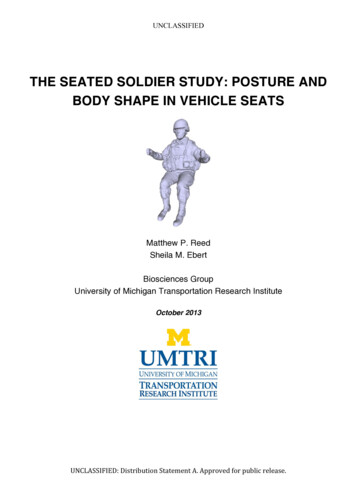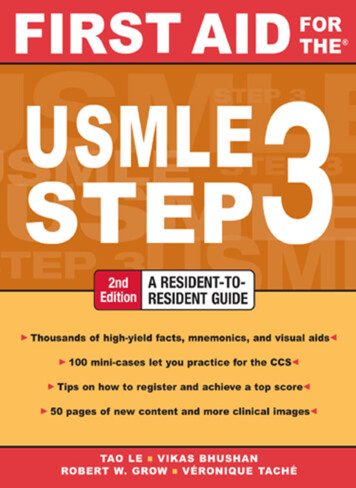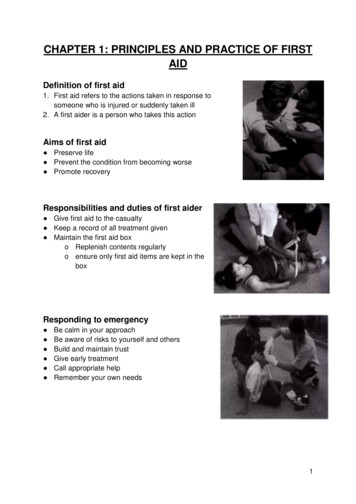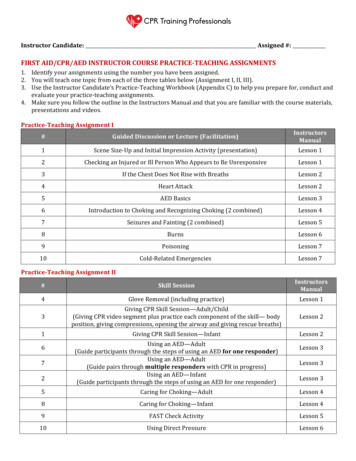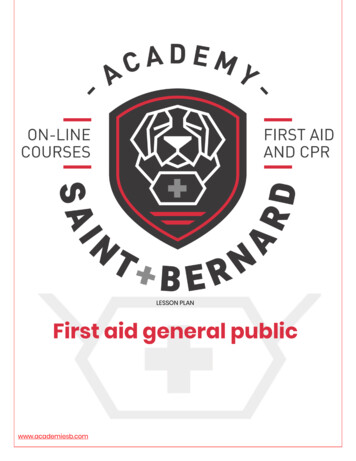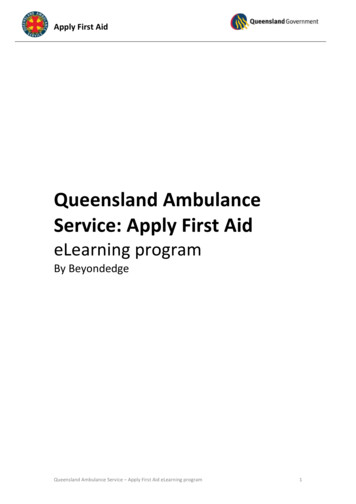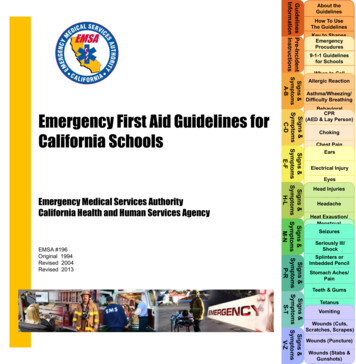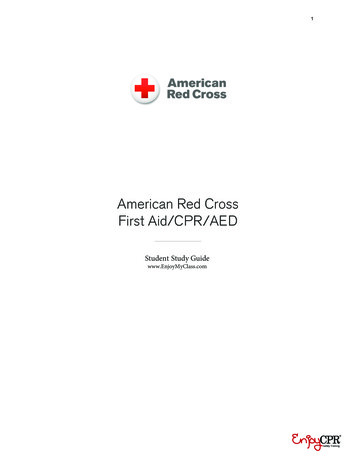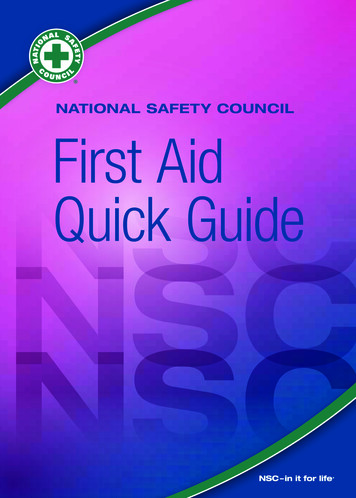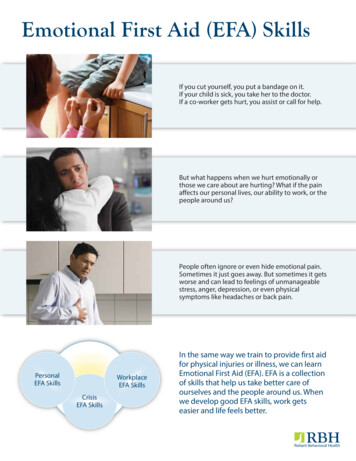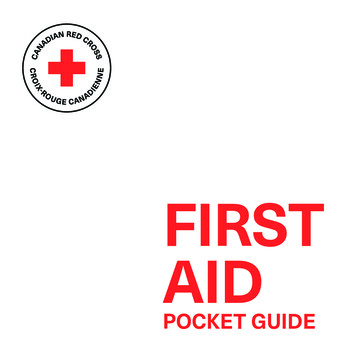
Transcription
FM 21-11C1HEADQUARTERSDEPARTMENT OF THE ARMYWashington, DC, 28 August 1989CHANGENo. 1FIRST AID FOR SOLDIERSFM 21-11, 27 October 1988, is changed as follows:1. New or changed material is indicated by a star ( ).2. Remove old pages and insert new ones as indicated below:Remove pagesC-9 through C-12Index-1 and Index-2Insert pagesC-9 and C-10Index-1 and Index-23. File this transmittal sheet in front of the publication.DISTRIBUTION RESTRICTION: Distribution authorized to US Governmentagencies only. This limited distribution is intended to protect technical oroperational information from automatic dissemination under the InternationalExchange Program or by other means. This determination was made on 27 July1988. Other requests for this document will be referred to Commandant, AHS,USA, ATTN: HSHA-TLD, Fort Sam Houston, TX 78234-6100.DESTRUCTION NOTICE: Destroy by any method that will prevent disclosure ofcontents or reconstruction of the document.
By Order of the Secretary of the Army:CARL E. VUONOGeneral, United States ArmyChief of StaffOfficial:WILLIAM J. MEEHAN IIBrigadier General, United States ArmyThe Adjutant GeneralDISTRIBUTION:Active Army, USAR and ARNG: To be distributed in accordance with DAForm 12-11E, requirements for FM 21-11, First Aid for Soldiers (Qty rqrblock no. 161).
CHANGENo. 2FM 21-11C2HEADQUARTERSDEPARTMENT OF THE ARMYWashington, DC, 4 December 1991FIRST AID FOR SOLDIERSFM 21-11, 27 October 1988, is changed as follows:1. New or changed material is indicated by a star ( ).2. Remove old pages and insert new ones as indicated below:Insert pagesRemove pagesCoverCoveri through xviii through xviii1-3 through 1-61-3 through 1-62-1 through 2-62-1 through 2-62-9 through 2-142-9 through 2-14None2-15 through 2-202-21 and 2-222-21 and 2-222-25 and 2-262-25 and 2-262-37 through 2-402-37 through 2-403-1 and 3-23-1 and 3-23-5 and 3-63-5 and 3-63-13 and 3-143-13 and 3-143-23 and 3-243-23 and 3-243-27 and 3-283-27 and 3-284-3 and 4-44-3 and 4-45-3 through 5-85-3 through 5-85-17 and 5-185-17 and 5-185-21 and 5-225-21 and 5-226-5 and 6-66-5 and 6-66-13 through 6-166-13 through 6-16NoneD-1 through D-4Glossary-1 and Glossary-2Glossary-1 and Glossary-2References-1 through References-3References-1 and References-2Index-0 through Index-6Index-1 through Index-83. File this transmittal sheet in front of the publication.DISTRIBUTION RESTRICTION: Approved for public release; distribution is unlimited.
By Order of the Secretary of the Army:GORDON R. SULLIVANGeneral, United States ArmyChief of StaffOfficial:MILTON H. HAMILTONAdministrative Assistant to theSecretary of the Army00105DISTRIBUTION:Active Army, USAR and ARNG: To be distributed in accordance with DAForm 12-11E, requirements for FM 21-11, First Aid for Soldiers (Qty rqrblock no. 161).
This publication contains copyrighted material.FIELD MANUAL*FM 21-11HEADQUARTERSDEPARTMENT OF THE ARMYWashington, DC, 27 October 1988FIRST AID FOR SOLDIERS TABLE OF CONTENTSi
C2, FM 21-11ii
C2, FM 21-11iii
C2, FM 21-11iv
C2, FM 21-11v
C2, FM 21-11LIST OF ILLUSTRATIONSvi
C2, FM 21-11vii
C2, FM 21-11viii
C2, FM 21-11ix
C2, FM 21-11x
C2, FM 21-11xi
C2, FM 21-11xii
C2, FM 21-11xiii
C2, FM 21-11xiv
C2, FM 21-11 PREFACEThis manual meets the emergency medical training needs of individualsoldiers. Because medical personnel will not always be readily available,the nonmedical soldiers will have to rely heavily on their own skills andknowledge of life-sustaining methods to survive on the integratedbattlefield. This manual also addresses first aid measures for other lifethreatening situations. It outlines both self-treatment (self-aid) and aid toother soldiers (buddy aid). More importantly, this manual emphasizesprompt and effective action in sustaining life and preventing orminimizing further suffering. First aid is the emergency care given to thesick, injured, or wounded before being treated by medical personnel. TheArmy Dictionary defines first aid as “urgent and immediate lifesavingand other measures which can be performed for casualties by nonmedicalpersonnel when medical personnel are not immediately available.”Nonmedical soldiers have received basic first aid training and shouldremain skilled in the correct procedures for giving first aid. Mastery offirst aid procedures is also part of a group study training programentitled the Combat Lifesaver (DA Pam 351-20). A combat lifesaver is anonmedical soldier who has been trained to provide emergency care. Thisincludes administering intravenous infusions to casualties as his combatmission permits. Normally, each squad, team, or crew will have onemember who is a combat lifesaver. This manual is directed to all soldiers.The procedures discussed apply to all types of casualties and themeasures described are for use by both male and female soldiers.Cardiopulmonary resuscitative (CPR) procedures were deleted from thismanual. These procedures are not recognized as essential battlefieldskills that all soldiers should be able to perform. Management andtreatment of casualties on the battlefield has demonstrated thatincidence of cardiac arrest are usually secondary to other injuriesrequiring immediate first aid. Other first aid procedures, such ascontrolling hemorrhage are far more critical and must be performed wellto save lives. Learning and maintaining CPR skills is time and resourceintensive. CPR has very little practical application to battlefield first aidand is not listed as a common task for soldiers. The Academy of HealthSciences, US Army refers to the American Heart Association for theCPR standard. If a nonmedical soldier desires to learn CPR, he maycontact his supporting medical treatment facility for the appropriateinformation. All medical personnel, however, must maintain proficiencyin CPR and may be available to help soldiers master the skill. The USArmy’s official reference for CPR is FM 8-230.This manual has been designed to provide a ready reference for theindividual soldier on first aid. Only the information necessary to supportand sustain proficiency in first aid has been boxed and the task numberhas been listed. In addition, these first aid tasks for Skill Level 1 havexv
C2, FM 21-11been listed in Appendix G. The task number, title, and specific paragraphof the appropriate information is provided in the event a cross-referenceis desired.AcknowledgmentGrateful acknowledgment is made to the American Heart Association fortheir permission to use the copyrighted material.Commercial ProductsCommercial products (trade names or trademarks) mentioned in thispublication are to provide descriptive information and for illustrativepurposes only. Their use does not imply endorsement by the Departmentof Defense.Standardization AgreementsThe provisions of this publication are the subject of internationalagreement(s):TITLENATO STANAG2122Medical Training in First Aid, BasicHygiene and Emergency Care2126First Aid Kits and Emergency MedicalCare Kits2358Medical First Aid and Hygiene Training inNBC Operations2871First Aid Material for Chemical InjuriesNeutral LanguageUnless this publication states otherwise, masculine nouns and pronounsdo not refer exclusively to men.AppendixesAppendix A is a listing of the contents of the First Aid Case and Kits.xvi
C2, FM 21-11Appendix B discusses some casualty transportation procedures. Much isdependent upon the manner in which a casualty is rescued andtransported.Appendix C outlines some basic principles that promote good health. Thehealth of the individual soldier is an important factor in conserving thefighting strength. History has often demonstrated that the course of thebattle is influenced more by the health of the soldier than by strategy ortactics.Appendix E discusses application of digital pressure and illustratespressure points.Appendix F discusses specific information on decontaminationprocedures.Appendix G is a listing of Skill Level 1 common tasks.Proponent StatementThe proponent of this publication is the Academy of Health Sciences, USArmy. Submit changes for improving this publication on DA Form 2028directly to Commandant, Academy of Health Sciences, US Army,ATTN: HSHA-CD, Fort Sam Houston, Texas 78234-6100.xvii
FM 21-11CHAPTER 1FUNDAMENTAL CRITERIA FOR FIRST AIDINTRODUCTIONSoldiers may have to depend upon their first aid knowledge and skills tosave themselves or other soldiers. They may be able to save a life, preventpermanent disability, and reduce long periods of hospitalization byknowing what to do, what not to do, and when to seek medical assistance.Anything soldiers can do to keep others in good fighting condition is partof the primary mission to fight or to support the weapons system. Mostinjured or ill soldiers are able to return to their units to fight and/orsupport primarily because they are given appropriate and timely first aidfollowed by the best medical care possible. Therefore, all soldiers mustremember the basics:Check for BREATHING: Lack of oxygen intake(through a compromised airway or inadequate breathing) can lead to braindamage or death in very few minutes.Check for BLEEDING: Life cannot continue withoutan adequate volume of blood to carry oxygen to tissues.Check for SHOCK: Unless shock is prevented ortreated, death may result even though the injury would not otherwise befatal.Section I. EVALUATE CASUALTY1-1.Casualty Evaluation (081-831-1000)The time may come when you must instantly apply your knowledge oflifesaving and first aid measures, possibly under combat or other adverseconditions. Any soldier observing an unconscious and/or ill, injured, orwounded person must carefully and skillfully evaluate him to determinethe first aid measures required to prevent further injury or death. Heshould seek help from medical personnel as soon as possible, but mustNOT interrupt his evaluation or treatment of the casualty. A secondperson may be sent to find medical help. One of the cardinal principles oftreating a casualty is that the initial rescuer must continue theevaluation and treatment, as the tactical situation permits, until he isrelieved by another individual. If, during any part of the evaluation, thecasualty exhibits the conditions for which the soldier is checking, thesoldier must stop the evaluation and immediately administer first aid. Ina chemical environment, the soldier should not evaluate the casualty1-1
FM 21-11until the casualty has been masked and given the antidote. Afterproviding first aid, the soldier must proceed with the evaluation andcontinue to monitor the casualty for further medical complications untilrelieved by medical personnel. Learn the following procedures well. Youmay become that soldier who will have to give first aid some day.NOTERemember, when evaluating and/or treating acasualty, you should seek medical aid as soonas possible. DO NOT stop treatment, but if thesituation allows, send another person to findmedical aid.WARNINGAgain, remember, if there are any signs ofchemical or biological agent poisoning, youshould immediately mask the casualty. If it isnerve agent poisoning, administer the antidote,using the casualty’s injector/ampules. See task081-831-1031, Administer First Aid to a NerveAgent Casualty (Buddy Aid).a. Step ONE. Check the casualty for responsiveness by gentlyshaking or tapping him while calmly asking, “Are you okay?” Watch forresponse. If the casualty does not respond, go to step TWO. See Chapter2, paragraph 2-5 for more information. If the casualty responds, continuewith the evaluation.(1) If the casualty is conscious, ask him where he feelsdifferent than usual or where it hurts. Ask him to identify the locationsof pain if he can, or to identify the area in which there is no feeling.(2) If the casualty is conscious but is choking and cannottalk, stop the evaluation and begin treatment. See task 081-831-1003Clear an Object from the Throat of a Conscious Casualty. Also seeChapter 2, paragraph 2-13 for specific details on opening the airway.1-2
C 2, FM 21-11WARNINGIF A BROKEN NECK OR BACK ISSUSPECTED, DO NOT MOVE THECASUALTY UNLESS TO SAVE HIS LIFE.MOVEMENT MAY CAUSE PERMANENTPARALYSIS OR DEATH.b. Step TWO. Check for breathing. See Chapter 2, paragraph2-5c for procedure.(1) If the casualty is breathing, proceed to step FOUR.(2) If the casualty is not breathing, stop the evaluation andbegin treatment (attempt to ventilate). See task 081-831-1042, PerformMouth-to-Mouth Resuscitation. If an airway obstruction is apparent,clear the airway obstruction, then ventilate.(3) After successfully clearing the casualty’s airway,proceed to step THREE.c. Step THREE. Check for pulse. If pulse is present, and thecasualty is breathing, proceed to step FOUR.(1) If pulse is present, but the casualty is still notbreathing, start rescue breathing. See Chapter 2, paragraphs 2-6, and 2-7for specific methods.for help. (2) If pulse is not found, seek medically trained personneld. Step FOUR. Check for bleeding. Look for spurts of blood orblood-soaked clothes. Also check for both entry and exit wounds. If thecasualty is bleeding from an open wound, stop the evaluation and beginfirst aid treatment in accordance with the following tasks, asappropriate:(1) Arm or leg wound–Task 081-831-1016, Put on a Field orPressure Dressing. See Chapter 2, paragraphs 2-15, 2-17, 2-18, and 2-19.(2) Partial or complete amputation–Task 081-831-1017,Put on a Tourniquet. See Chapter 2, paragraph 2-20.(3) Open head wound–Task 081-831-1033, Apply aDressing to an Open Head Wound. See Chapter 3, Section I.1-3
C 2, FM 21-11(4) Open abdominal wound–Task 081-831-1025, Apply aDressing to an Open Abdominal Wound. See Chapter 3, paragraph 3-12.(5) Open chest wound–Task 081-831-1026, Apply aDressing to an Open Chest Wound. See Chapter 3, paragraphs 3-9 and3-10.WARNINGIN A CHEMICALLY CONTAMINATEDAREA, DO NOT EXPOSE THE WOUND(S).e. Step FIVE. Check for shock. If signs/symptoms of shock arepresent, stop the evaluation and begin treatment immediately. Thefollowing are nine signs and/or symptoms of shock.(1)Sweaty but cool skin (clammy skin).(2)Paleness of skin.(3)Restlessness or nervousness.(4)Thirst.(5)Loss of blood (bleeding).(6)Confusion (does not seem aware of surroundings).(7)Faster than normal breathing rate.(8)Blotchy or bluish skin, especially around the mouth.(9)Nausea and/or vomiting.WARNINGLEG FRACTURES MUST BE SPLINTEDBEFORE ELEVATING THE LEGS/AS ATREATMENT FOR SHOCK.See Chapter 2, Section III for specific information regarding the causesand effects, signs/symptoms, and the treatment/prevention of shock.1-4
C 2, FM 21-11f. Step SIX. Check for fractures (Chapter 4).(1) Check for the following signs/symptoms of a back orneck injury and treat as necessary.Pain or tenderness of the neck or back area.Cuts or bruises in the neck or back area.numbness).Inability of a casualty to move (paralysis orAsk about ability to move (paralysis).Touch the casualty’s arms and legs and askwhether he can feel your hand (numbness).Unusual body or limb position.WARNINGUNLESS THERE IS IMMEDIATE LIFETHREATENING DANGER, DO NOT MOVEA CASUALTY WHO HAS A SUSPECTEDBACK OR NECK INJURY. MOVEMENTMAY CAUSE PERMANENT PARALYSISOR DEATH.(2) Immobilize any casualty suspected of having a neck orback injury by doing the followingTell the casualty not to move.If a back injury is suspected, place padding (rolledor folded to conform to the shape of the arch) under the natural arch ofthe casualty’s back. For example, a blanket may be used as padding.If a neck injury is suspected, place a roll of clothunder the casualty’s neck and put weighted boots (filled with dirt, sandand so forth) or rocks on both sides of his head.fractures.(3) Check the casualty’s arms and legs for open or closed1-5
C 2, FM 21-11Check for open fractures.Look for bleeding.Look for bone sticking through the skin.Check for closed fractures.Look for swelling.Look for discoloration.Look for deformity.Look for unusual body position. (4) Stop the evaluation and begin treatment if a fracture toan arm or leg is suspected. See Task 081-831-1034, Splint a SuspectedFracture, Chapter 4, paragraphs 4-4 through 4-7.(5) Check for signs/symptoms of fractures of other bodyareas (for example, shoulder or hip) and treat as necessary.g. Step SEVEN. Check for burns. Look carefully for reddenedblistered, or charred skin, also check for singed clothing. If bums arefound, stop the evaluation and begin treatment (Chapter 3, paragraph3-14). See task 081-831-1007, Give First Aid for Burns.h. Step EIGHT. Check for possible head injury.(1) Look for the following signs and symptomsUnequal pupils.Fluid from the ear(s), nose, mouth, or injury site.Slurred speech.Confusion.Sleepiness.Loss of memory or consciousness.Staggering in walking.1-6
FM 21-11Headache.Dizziness.Vomiting and/or nausea.Paralysis.Convulsions or twitches.(2) If a head injury is suspected, continue to watch for signswhich would require performance of mouth-to-mouth resuscitation,treatment for shock, or control of bleeding and seek medical aid. SeeChapter 3, Section I for specific indications of head injury and treatment.See task 081-831-1033, Apply a Dressing to an Open Head Wound.1-2.Medical Assistance (081-831-1000)When a nonmedically trained soldier comes upon an unconscious and/orinjured soldier, he must accurately evaluate the casualty to determine thefirst aid measures needed to prevent further injury or death. He should seekmedical assistance as soon as possible, but he MUST NOT interrupttreatment. To interrupt treatment may cause more harm than good to thecasualty. A second person may be sent to find medical help. If, during anypart of the evaluation, the casualty exhibits the conditions for which thesoldier is checking, the soldier must stop the evaluation and immediatelyadminister first aid. Remember that in a chemical environment, the soldiershould not evaluate the casualty until the casualty has been masked andgiven the antidote. After performing first aid, the soldier must proceed withthe evaluation and continue to monitor the casualty for development ofconditions which may require the performance of necessary basic life savingmeasures, such as clearing the airway, mouth-to-mouth resuscitation,preventing shock, ardor bleeding control. He should continue to monitoruntil relieved by medical personnel.Section II. UNDERSTAND VITAL BODY FUNCTIONS1-3. Respiration and Blood CirculationRespiration (inhalation and exhalation) and blood circulation are vitalbody functions. Interruption of either of these two functions need not befatal IF appropriate first aid measures are correctly applied.1-7
FM 21-11a. Respiration. When a person inhales, oxygen is taken into thebody and when he exhales, carbon dioxide is expelled from the body–thisis respiration. Respiration involves the—Airway (nose, mouth, throat, voice box, windpipe, andbronchial tree). The canal through which air passes to and from the lungs.Lungs (two elastic organs made up of thousands of tinyair spaces and covered by an airtight membrane).Chest cage (formed by the muscle-connected ribs whichjoin the spine in back and the breastbone in front). The top part of thechest cage is closed by the structure of the neck, and the bottom part isseparated from the abdominal cavity by a large dome-shaped musclecalled the diaphragm (Figure 1-1). The diaphragm and rib muscles, whichare under the control of the respiratory center in the brain, automaticallycontract and relax. Contraction increases and relaxation decreases thesize of the chest cage.When the chest cage increases and then decreases, the air pressure in thelungs is first less and then more than the atmospheric pressure, thuscausing the air to rush in and out of the lungs to equalize the pressure.This cycle of inhaling and exhaling is repeated about 12 to 18 times perminute.1-8
FM 21-11b. Blood Circulation. The heart and the blood vessels (arteries,veins, and capillaries) circulate blood through the body tissues. The heartis divided into two separate halves, each acting as a pump. The left sidepumps oxygenated blood (bright red) through the arteries into thecapillaries; nutrients and oxygen pass from the blood through the wallsof the capillaries into the cells. At the same time waste products andcarbon dioxide enter the capillaries. From the capillaries the oxygen poorblood is carried through the veins to the right side of the heart and theninto the lungs where it expels carbon dioxide and picks up oxygen, Bloodin the veins is dark red because of its low oxygen content. Blood does notflow through the veins in spurts as it does through the arteries.(1) Heartbeat. The heart functions as a pump to circulatethe blood continuously through the blood vessels to all parts of the body.It contracts, forcing the blood from its chambers; then it relaxes,permitting its chambers to refill with blood. The rhythmical cycle ofcontraction and relaxation is called the heartbeat. The normal heartbeatis from 60 to 80 beats per minute.(2) Pulse. The heartbeat causes a rhythmical expansion andcontraction of the arteries as it forces blood through them. This cycle ofexpansion and contraction can be felt (monitored) at various body pointsand is called the pulse. The common points for checking the pulse are atthe side of the neck (carotid), the groin (femoral), the wrist (radial), andthe ankle (posterial tibial).(a) Neck (carotid) pulse. To check the neck (carotid)pulse, feel for a pulse on the side of the casualty’s neck closest to you byplacing the tips of your first two fingers beside his Adam’s apple (Figure1-2).1-9
FM 21-11(b) Groin (femoral) pulse. To check the groin (femoral)pulse, press the tips of two fingers into the middle of the groin (Figure1-3).(c) Wrist (radial) pulse. To check the wrist (radial)pulse, place your first two fingers on the thumb side of the casualty’swrist (Figure 1-4).1-10
FM 21-11(d) Ankle (posterial tibial) pulse. To check the ankle(posterial tibial) pulse, place your first two fingers on the inside of theankle (Figure 1-5).NOTEDO NOT use your thumb to check a casualty’spulse because you may confuse your pulse beatwith that of the casualty.1-4. Adverse Conditionsa. Lack of Oxygen. Human life cannot exist without acontinuous intake of oxygen. Lack of oxygen rapidly leads to death. Firstaid involves knowing how to OPEN THE AIRWAY AND RESTOREBREATHING AND HEARTBEAT (Chapter 2, Section I).b. Bleeding. Human life cannot continue without an adequatevolume of blood to carry oxygen to the tissues. An important first aidmeasure is to STOP THE BLEEDING to prevent loss of blood (Chapter2, Section II).1-11
FM 21-11c. Shock. Shock means there is inadequate blood flow to thevital tissues and organs. Shock that remains uncorrected may result indeath even though the injury or condition causing the shock would nototherwise be fatal. Shock can result from many causes, such as loss ofblood, loss of fluid from deep burns, pain, and reaction to the sight of awound or blood. First aid includes PREVENTING SHOCK, since thecasualty’s chances of survival are much greater if he does not developshock (Chapter 2, Section III).d. Infection. Recovery from a severe injury or a wound dependslargely upon how well the injury or wound was initially protected.Infections result from the multiplication and growth (spread) of germs(bacteria: harmful microscopic organisms). Since harmful bacteria are inthe air and on the skin and clothing, some of these organisms willimmediately invade (contaminate) a break in the skin or an open wound.The objective is to KEEP ADDITIONAL GERMS OUT OF THEWOUND. A good working knowledge of basic first aid measures alsoincludes knowing how to dress the wound to avoid infection or additionalcontamination (Chapters 2 and 3).1-12
C 2, FM 21-11CHAPTER 2BASIC MEASURES FOR FIRST AIDINTRODUCTIONSeveral conditions which require immediate attention are an inadequateairway, lack of breathing or lack of heartbeat, and excessive loss of blood.A casualty without a clear airway or who is not breathing may die fromlack of oxygen. Excessive loss of blood may lead to shock, and shock canlead to death; therefore, you must act immediately to control the loss ofblood. All wounds are considered to be contaminated, since infectionproducing organisms (germs) are always present on the skin, on clothing,and in the air. Any missile or instrument causing the wound pushes orcarries the germs into the wound. Infection results as these organismsmultiply. That a wound is contaminated does not lessen the importanceof protecting it from further contamination. You must dress and bandagea wound as soon as possible to prevent further contamination. It is alsoimportant that you attend to any airway, breathing, or bleeding problemIMMEDIATELY because these problems may become life-threatening.Section I. OPEN THE AIRWAY AND RESTORE BREATHING 2-1.Breathing ProcessAll living things must have oxygen to live. Through the breathingprocess, the lungs draw oxygen from the air and put it into the blood. Theheart pumps the blood through the body to be used by the living cellswhich require a constant supply of oxygen. Some cells are moredependent on a constant supply of oxygen than others. Cells of the brainmay die within 4 to 6 minutes without oxygen. Once these cells die, theyare lost forever since they DO NOT regenerate. This could result inpermanent brain damage, paralysis, or death.2-2.Assessment (Evaluation) Phase (081-831-1000 and 081-831-1042)a. Check for responsiveness (Figure 2-1A)—establish whetherthe casualty is conscious by gently shaking him and asking, “Are youO.K.?”b. Call for help (Figure 2-1B).2-1
C 2, FM 21-11c. Position the unconscious casualty so that he is lying on hisback and on a firm surface (Figure 2-1C) (081-831-1042).WARNING (081-831-1042)If the casualty is lying on his chest (proneposition), cautiously roll the casualty as a unitso that his body does not twist (which mayfurther complicate a neck, back or spinalinjury).2-2
C 2, FM 21-11(1) Straighten the casualty’s legs. Take the casualty’s armthat is nearest to you and move it so that it is straight and above hishead. Repeat procedure for the other arm.(2) Kneel beside the casualty with your knees near hisshoulders (leave space to roll his body) (Figure 2-1B). Place one handbehind his head and neck for support. With your other hand, grasp thecasualty under his far arm (Figure 2-1C).(3) Roll the casualty toward you using a steady andeven pull. His head and neck should stay in line with his back.(4) Return the casualty’s arms to his sides. Straighten hislegs. Reposition yourself so that you are now kneeling at the level of thecasualty’s shoulders. However, if a neck injury is suspected, and the jawthrust will be used, kneel at the casualty’s head, looking toward his feet.2-3.Opening the Airway—Unconscious and Not BreathingCasualty (081-831-1042) The tongue is the single most common cause of an airway obstruction(Figure 2-2). In most cases, the airway can be cleared by simply using thehead-tilt/chin-lift technique. This action pulls the tongue away from theair passage in the throat (Figure 2-3).2-3
C 2, FM 21-11a. Step ONE (081-331-1042). Call for help and then position thecasualty. Move (roll) the casualty onto his back (Figure 2-1C above).CAUTIONTake care in moving a casualty with asuspected neck or back injury. Moving aninjured neck or back may permanently injurethe spine.NOTE (081-831-1042)If foreign material or vomitus is visible in themouth, it should be removed, but do not spendan excessive amount of time doing so.b. Step TWO (081-831-1042). Open the airway using the jawthrust or head-tilt/chin-lift technique.2-4
C2, FM 21-11NOTEThe head-tilt/chin-lift is an importantprocedure in opening the airway; however, useextreme care because excess force inperforming this maneuver may cause furtherspinal injury. In a casualty with a suspectedneck injury or severe head trauma, the safestapproach to opening the airway is the jawthrust technique because in most cases it canbe accomplished without extending the neck.¹(1) Perform the jaw-thrust technique. The jaw-thrust maybe accomplished by the rescuer grasping the angles of the casualty’slower jaw and lifting with both hands, one on each side, displacing thejaw forward and up (Figure 2-4). The rescuer’s elbows should rest on thesurface on which the casualty is lying. If the lips close, the lower lip canbe retracted with the thumb. If mouth-to-mouth breathing is necessary,close the nostrils by placing your cheek tightly against them. The headshould be carefully supported without tilting it backwards or turning itfrom side to side. If this is unsuccessful, the head should be tilted backvery slightly.² The jaw-thrust is the safest first approach to opening theairway of a casualty who has a suspected neck injury because in mostcases it can be accomplished without extending the neck.1. American Heart Association (AHA). Instructor’s Manual for Basic Life Support (Dallas:AHA, 1987), p. 37.2. Ibid.2-5
C2, FM 21-11(2) Perform the head-tilt/chin-lift technique (081-831-1042).Place one hand on the casualty’s forehead and apply firm, backwardpressure with the palm to tilt the head back. Place the fingertips of theother hand under the bony part of the lower jaw and lift, bringing thechin forward. The thumb should not be used to lift the chin (Figure 2-5).NOTEThe fingers should not press deeply into thesoft tissue under the chin because the airwaymay be obstructed.c. Step THREE. Check for breathing (while maintaining anairway). After establishing an open airway, it is important to maintainthat airway in an open position. Often the act of just opening andmaintaining the airway will allow the casualty to breathe properly. Oncethe rescuer uses one of the techniques to open the airway (jaw-thrust orhead-tilt/chin-lift), he should maintain that head position to keep theairway open. Fail
Nonmedical soldiers have received basic first aid training and should remain skilled in the correct procedures for giving first aid. Mastery of first aid procedures is also part of a group study training program entitled the Combat Lifesaver (DA Pam 351-20). A combat lifesaver is a nonmedi
